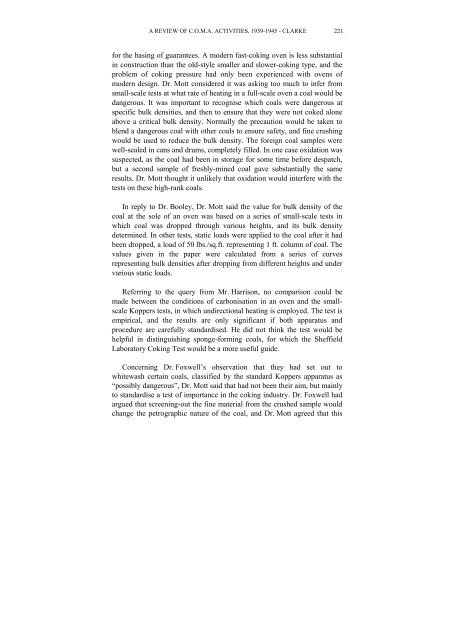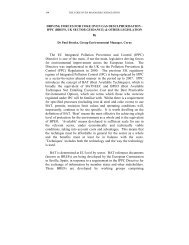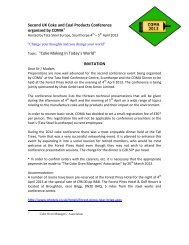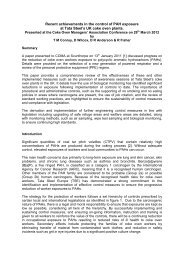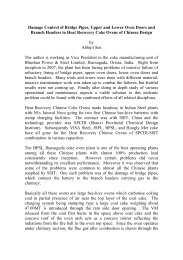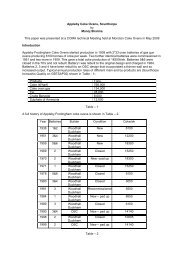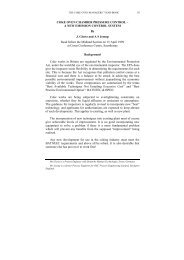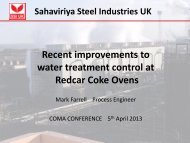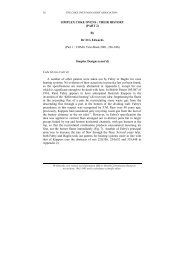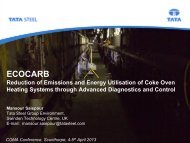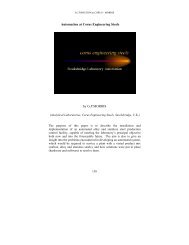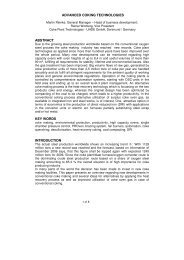CHAIRMAN'S ADDRESS - Coke Oven Managers Association
CHAIRMAN'S ADDRESS - Coke Oven Managers Association
CHAIRMAN'S ADDRESS - Coke Oven Managers Association
- No tags were found...
Create successful ePaper yourself
Turn your PDF publications into a flip-book with our unique Google optimized e-Paper software.
A REVIEW OF C.O.M.A. ACTIVITIES, 1939-1945 - CLARKE 221.for the basing of guarantees. A modern fast-coking oven is less substantialin construction than the old-style smaller and slower-coking type, and theproblem of coking pressure had only been experienced with ovens ofmodern design. Dr. Mott considered it was asking too much to infer fromsmall-scale tests at what rate of heating in a full-scale oven a coal would bedangerous. It was important to recognise which coals were dangerous atspecific bulk densities, and then to ensure that they were not coked aloneabove a critical bulk density. Normally the precaution would be taken toblend a dangerous coal with other coals to ensure safety, and fine crushingwould be used to reduce the bulk density. The foreign coal samples werewell-sealed in cans and drums, completely filled. In one case oxidation wassuspected, as the coal had been in storage for some time before despatch,but a second sample of freshly-mined coal gave substantially the sameresults. Dr. Mott thought it unlikely that oxidation would interfere with thetests on these high-rank coals.In reply to Dr. Booley, Dr. Mott said the value for bulk density of thecoal at the sole of an oven was based on a series of small-scale tests inwhich coal was dropped through various heights, and its bulk densitydetermined. In other tests, static loads were applied to the coal after it hadbeen dropped, a load of 50 lbs./sq.ft. representing 1 ft. column of coal. Thevalues given in the paper were calculated from a series of curvesrepresenting bulk densities after dropping from different heights and undervarious static loads.Referring to the query from Mr. Harrison, no comparison could bemade between the conditions of carbonisation in an oven and the smallscaleKoppers tests, in which undirectional heating is employed. The test isempirical, and the results are only significant if both apparatus andprocedure are carefully standardised. He did not think the test would behelpful in distinguishing sponge-forming coals, for which the SheffieldLaboratory Coking Test would be a more useful guide.Concerning Dr. Foxwell’s observation that they had set out towhitewash certain coals, classified by the standard Koppers apparatus as“possibly dangerous”, Dr. Mott said that had not been their aim, but mainlyto standardise a test of importance in the coking industry. Dr. Foxwell hadargued that screening-out the fine material from the crushed sample wouldchange the petrographic nature of the coal, and Dr. Mott agreed that this


